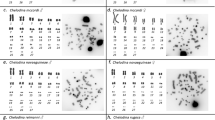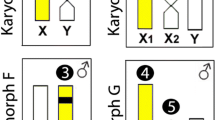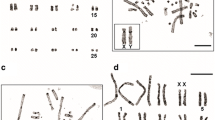Abstract
Heteromorphic sex chromosomes are rare in turtles, having been described in only four species. Like many turtle species, the Australian freshwater turtle Chelodina longicollis has genetic sex determination, but no distinguishable (heteromorphic) sex chromosomes were identified in a previous karyotyping study. We used comparative genomic hybridization (CGH) to show that C. longicollis has an XX/XY system of chromosomal sex determination, involving a pair of microchromosomes. C-banding and reverse fluorescent staining also distinguished microchromosomes with different banding patterns in males and females in ∼70% cells examined. GTG-banding did not reveal any heteromorphic chromosomes, and no replication asynchrony on the X or Y microchromosomes was observed using replication banding. We conclude that there is a very small sequence difference between X and Y chromosomes in this species, a difference that is consistently detectable only by high-resolution molecular cytogenetic techniques, such as CGH. This is the first time a pair of microchromosomes has been identified as the sex chromosomes in a turtle species.
Similar content being viewed by others
References
Balaresque P, Toupance N, Lluis QM, Crouau-Roy B, Heyer E (2004) Sex-specific selection on the human X chromsosome. Genet Res 83: 169–176.
Bickham JW (1975) A cytosystemic study of turtles in the genera Clemys and Sacalia. Herpetologica 31: 198–204.
Barzotti R, Pelliccia F, Rocchi A (2000) Sex chromosome differentiation revealed by genomic in situ hybridization. Chromosom Res 8: 459–464.
Bull JJ, Legler JM (1980) Karyotypes of side-necked turtles (Testudines: Pleurodira). Can J Zool 58: 828–841.
Charlesworth B (1996) The evolution of chromosomal sex determination and dosage compensation. Curr Biol 6: 149–162.
Charlesworth D, Charlesworth B, Marais G (2005) Steps in the evolution of heteromorphic sex chromosomes. Heredity 95: 118–128.
Donnellan SC (1985) The evolution of sex chromosomes in scincid lizards. PhD Thesis, Macquarie University, NSW, Australia.
Ezaz MT, McAndrew BJ, Penman DJ (2004) Spontaneous diploidization of maternal chromosome set in Nile tilapia (Oreochromis niloticus) eggs. Aquac Res 35: 271–277.
Ezaz T, Quinn AE, Miura I, Sarre SD, Georges A, Graves JAM (2005) The dragon lizard Pogona vitticeps has ZZ/ZW micro-sex chromosomes. Chromosom Res 13: 763–776.
Fitzpatrick MJ (2004) Pleiotropy and the genomic location of sexually selected genes. Am Nat 163: 800–808.
Georges A (1988) Sex determination is independent of incubation-temperature in another chelid turtle, Chelodina longicollis. Copeia 1988(1): 248–254.
Gorman GC (1973) The chromosomes of the Reptilia, a cytotaxonomic interpretation. In: Ciarelli AB, Capanna E, eds. Cytotaxonomy and Vertebrate Evolution. London, New York: Academic Press, pp. 349–424.
Graves JAM, Gecz J, Hameister H (2002) Evolution of the human X – a smart and sexy chromosome that controls speciation and development. Cytogenet Genome Res 99: 141–145.
Harlow PS (2001) The ecology of sex-determining mechanisms in Australian agamid lizards. PhD Thesis, School of Biological Sciences. Macquarie University, Sydney.
Janzen FJ, Krenz JG (2004) Phylogenetics: which was first, TSD or GSD? In: Valenzuela N, Lance VA, eds. Temperature Dependent Sex Determination in Vertebrates. Washington DC: Smithsonian Books, pp. 121–130.
Lindholm AK, Brooks R, Breden F (2004) Extreme polymorphism in a Y-linked sexually selected trait. Heredity 92: 156–162.
McBee K, Bickham JW, Rhodin AGJ, Mittermeier RA (1985) Karyotypic variation in the genus Platemys (Testudines: Pleurodira). Copeia 1985(2): 445–449.
Miura I (1995) The late replicating banding patterns of chromosomes are highly conserved in the genera Rana, Hyla, and Bufo (Amphibia, Anura). Chromosoma 103: 567–574.
Olmo E (1986) A. Reptilia. In: John B, ed. Animal Cytogenetics 4 Chordata 3. Gebruder Berlin-Stuttgart: Bortraeger.
Olmo E, Cobror O, Morescalchi A, Odierna G (1984) Homomorphic sex chromosomes in lacertid lizard Takydromus sexlineatus. Heredity 53: 457–459.
Olmo E, Signorino G (2005) Chromorep: a reptile chromosomes database. Internet reference retrieved from http://193.206.118.100/professori/chromorep.pdf.
Palmer-Allen M, Beynon F, Georges A (1991) Hatchling sex-ratios are independent of temperature in field nests of the long-necked turtle, Chelodina longicollis (Testudinata, Chelidae). Wild Res 18: 225–231.
Ray-Chaudhury SP, Singh L, Sharma T (1971) Evolution of sex chromosomes and formation of W chromatin in snakes. Chromosoma 33: 239–251.
Reeve HK, Pfennig DW (2003) Genetic biases for showy males: Are some genetic systems especially conducive to sexual selection? Proc Natl Acad Sci USA 100:1089–1094.
Rice WR (1984) Sex-chromosomes and the evolution of sexual dimorphism. Evolution 38: 735–742.
Sarre SD, Georges A, Quinn A (2004) The ends of a continuum: genetic and temperature-dependent sex determination in reptiles. Bioessays 26: 639–645.
Schweizer D (1976) Reverse fluorescent chromosome banding with chromomycin and DAPI. Chromosoma 58: 307–324.
Singh L, Purdom IF, Jones KW (1976) Satellite DNA and evolution of sex chromosomes. Chromosoma 76: 137–157.
Sites JW, Bickham JW, Haiduk MW (1979) Derived sex-chromosome in the turtle genus Strurotypus. Science 206: 1410–1412.
Solari AJ (1994) Sex Chromosomes and Sex Determination in Vertebrates, Boca Raton, Florida: CRC Press Inc.
Traut W, Sahara K, Otto TD, Marec F (1999) Molecular differentiation of sex chromosomes probed by comparative genomic hybridization. Chromosoma 108: 173–180.
Traut W, Eickhoff U, Schorch J (2001) Identification and analysis of sex chromosomes by comparative genomic hybridization (CGH). Methods Cell Sci 23: 155–161.
Uetz P (2005) The EMBL reptile database. Internet references. Retrieved from: http://www.reptile-database.org, 31 October 2005.
Valenzuela N, Lance VA (2004) Temperature Dependent Sex Determination in Vertebrates. Washington DC: Smithsonian Books.
Valenzuela, N, Adams DC, Janzen FJ (2003) Exactly when is sex environmentally determined? Am Nat 161: 676–683.
Verma RS, Babu A (1995) Human Chromosomes: Principles and Techniques. Second Edition. New York: McGraw-Hill, Inc.
Viets BE, Ewert MA, Talent LG, Nelson CE (1994) Sex determining mechanisms in squamate reptiles. J Exp Zool 270: 45–56.
Witten JG (1983) Some karyotypes of Australian agamids (Reptilia: Lacertilia). Aust J Zoology 31: 533–540.
Author information
Authors and Affiliations
Corresponding author
Rights and permissions
About this article
Cite this article
Ezaz, T., Valenzuela, N., Grützner, F. et al. An XX/XY sex microchromosome system in a freshwater turtle, Chelodina longicollis (Testudines: Chelidae) with genetic sex determination. Chromosome Res 14, 139–150 (2006). https://doi.org/10.1007/s10577-006-1029-6
Received:
Accepted:
Published:
Issue Date:
DOI: https://doi.org/10.1007/s10577-006-1029-6




